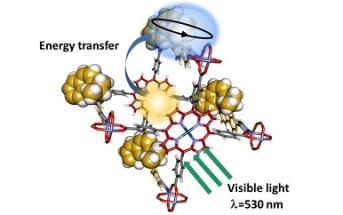
What can we achieve by combining a photosensitizing molecule in a crystal that captures green light and a molecular motor? An artificial leaf that captures the light, transforms it into energy that powers the motor in a unidirectional rotary motion.
This is the result of the study conducted by the research group led by Prof. Angiolina Comotti, professor of Industrial Chemistry of the Department of Materials Science of the University of Milan - Bicocca, and by the research group of Prof. Ben Feringa from University of Groningen, Nobel laureate in 2016 for the discovery of molecular machines. Thanks to the international collaboration of the two teams, it was possible to develop an innovative approach that allows you to effectively exploit the common visible light to activate the molecular engine, thanks to the intermolecular sensitization by transferring energy from a second molecule (chromophore). The research Visible-Light-Driven Rotation of Molecular Motors in a Dual-Function Metal–Organic Framework Enabled by Energy Transfer” (doi.org/10.1021/jacs.0c03063) has been published in Journal of the American Chemical Society (Impact factor 14.695, - 2018 Journal Impact Factor, Journal Citation Reports (Clarivate Analytics, 2019)).
What are molecular machines and motors? And how to put them into operation?
Molecular machines and motors are the machines produced on the smallest possible scale, that is, on the molecular scale - explains Prof. Comotti. - To produce them, we need some ingredients: a solid material that supports a large number of molecular machines, because they assume a collective functionality, the existence of easily rotating elements in the material on which the movement hinges and a mechanism of transformation of the energy in unidirectional molecular motion. Given these principles, machines even smaller than the size of biological cells and comparable to biological membrane systems, such as the proton pump, have been created.
What is the novelty in this study?
The current challenge is to obtain rotary motion in organized and orderly structures such as crystals and to activate molecular motors from widely available forms of energy with an energetically sustainable process - continues Angiolina Comotti. - Both of these results were achieved by integrating a molecular motor and a molecule capable of capturing sunlight, similar to that found in chlorophyll, into a periodic crystal structure. The molecular engine would work with higher energy radiation, which would affect its operation in environmental conditions. The ordered integration of the two components with the formation of stable bonds has produced a complex solid capable of absorbing light and producing unidirectional molecular movement, with the prospect of manufacturing actuators operated by light.
How does this discovery fit on the international scene?
The development of artificial molecular machines and motors has allowed the design and construction of architectures capable of carrying out controlled motions on the nanoscale. Among these artificial systems, the molecular motors that contain an alkene group have attracted a lot of attention as their photochemically controlled chirality drives the unidirectional rotary motion. Although these molecules have been shown to perform various functions in solution, for example the stereochemical control of catalytic reactions, the Brownian motions prevent the cooperative action required to obtain functions on the macroscale. Instead in the solid state and organized media this problem has been overcome. In addition, the aforementioned molecular motors are typically stimulated by high energy ultraviolet light which can cause destructive photochemical processes
With this research, we have shown how it is possible to build a new supramolecular architecture that performs the dual function of both collecting light and transferring energy to the molecular engine, inducing rotary motion. The orderly arrangement of the two chromophores in the motorized crystalline material leads to an efficient transfer of energy with chemical photoisomerization of the molecular motor, stimulated by green light with a wavelength of 530 nm.
The discovery opens up new perspectives for future applications, for example membranes and molecular pumps to accelerate the flow of gas or in combination with miniaturized chemical reactors to accelerate the entry of reagents and the exit of products, powered by non-invasive visible light.